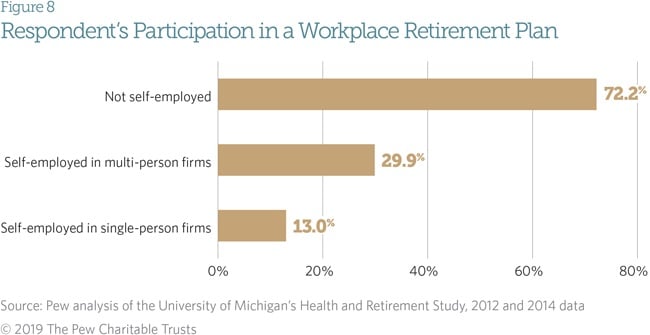 The larger labor force had a significant portion of independent workers long before phone-app disruptors became household names. (Photo: Shutterstock)
The larger labor force had a significant portion of independent workers long before phone-app disruptors became household names. (Photo: Shutterstock)
America's labor force is unequivocally shifting to more of the gig economy.
Or at least that's what could be reasonably inferred from the emergence of gig platforms such as Uber, Lyft, and TaskRabbit, and the countless headlines in the trade and mainstream media that suggest as much.
But the reality is that the larger labor force had a significant portion of independent workers long before phone-app disruptors became household names, says Alison Shelton, a senior officer on the retirement savings team at Pew Charitable Trusts.
 Figure 1: Participation in a workplace retirement plan (Image: Pew)
Figure 1: Participation in a workplace retirement plan (Image: Pew)In fact, "Uber et al" comprise only 1 to 2 percent of the independent workforce, which the Bureau of Labor Statistics says includes 15.5 million workers. And the percentage of independent workers has dropped slightly since 2005, from 10.7 percent to 10.1 percent of the total workforce, according to BLS data released in 2018.
Nevertheless, little is known about how pre-retirees among those independent contractors are positioned for retirement, which is why Pew set out to better understand the savings situation of independent workers between ages 50 to 65.
"Solo" self-employed versus independent workers in firms of 2 or more
Shelton and her team culled data from the University of Michigan's Health and Retirement Study, parsing data on the self-employed nearing retirement into two groups: the "solo" self-employed, and those independents who worked in firms with two or more people.
The savings of those two groups were compared to data on those in traditional full-time employment situations.
 Figure 2: Assets in defined contribution retirement plans. (Image: Pew Charitable Trusts)
Figure 2: Assets in defined contribution retirement plans. (Image: Pew Charitable Trusts)The unsurprising bottom line: The self-employed participated in workplace retirement plans at considerably lower rates than those in traditional jobs.
Of the solo independent sample, only 13 percent participate in a workplace plan. Of independents that work in multi-person firms, 29.9 percent save in a workplace plan. Of the sample in traditional employment arrangements, 72.2 percent participate in a workplace plan.
To paint a deeper picture, Pew then looked to see if spouses in those households had access to a workplace retirement plan.
Of the self-employed in single firms that don't have coverage, 58.2 percent had spouses that did have access to a workplace retirement plan.
Of the self-employed in multi-person firms without access to a plan, 42.5 percent had spouses who were covered.
For those in traditional employment situations without coverage, 55.9 percent had spouses who were covered.
Independent contractors in multi-person firms have highest average savings
For some in the so-called gig economy, independence has not meant sacrificing retirement savings.
When independents in multi-person firms do save, their average account balance was $384,737, compared to $122,800 for those in traditional jobs, and $61,735 for solo independent contractors.
Independent contractors in multi-person firms, who are more often highly educated doctors, lawyers, and engineers, had the highest median household income, at $150,000.
Median household income for the solo independent contractors was $86,804. For those in traditional jobs, median household income was $90,012.
© 2025 ALM Global, LLC, All Rights Reserved. Request academic re-use from www.copyright.com. All other uses, submit a request to [email protected]. For more information visit Asset & Logo Licensing.








